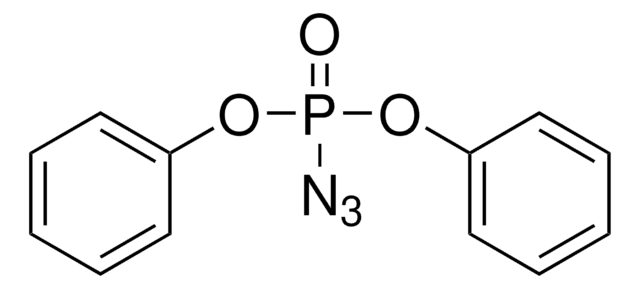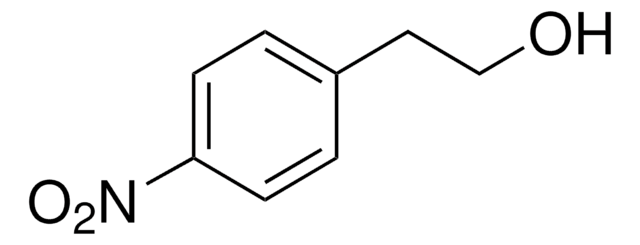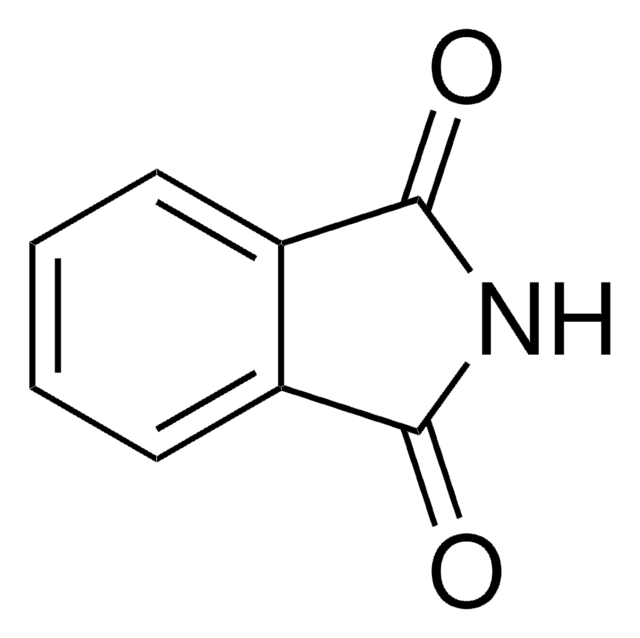563110
Diethyl azodicarboxylate solution
40 wt. % in toluene
Sinonimo/i:
1,2-Ethoxycarbonyl diazene solution, DEAD, Diethoxycarbonyldiazene solution, Diethyl azodiformate solution, NSC 3474, NSC 679015, Unifoam AZ-AE 200
About This Item
Prodotti consigliati
Concentrazione
40 wt. % in toluene
Indice di rifrazione
n20/D 1.4690
P. ebollizione
116-117 °C
Densità
0.956 g/mL at 25 °C
Gruppo funzionale
azo
Temperatura di conservazione
2-8°C
Stringa SMILE
CCOC(=O)\N=N/C(=O)OCC
InChI
1S/C6H10N2O4/c1-3-11-5(9)7-8-6(10)12-4-2/h3-4H2,1-2H3/b8-7+
FAMRKDQNMBBFBR-BQYQJAHWSA-N
Cerchi prodotti simili? Visita Guida al confronto tra prodotti
Descrizione generale
Applicazioni
- Immunostimulants α-Galactosylceramides
- Cellotriose and cellotetraose analogues as transition state mimics for mechanistic studies of cellulases
- Bisubstrate inhibitors with molecular recognition at the active site of catechol-O-methyltransferase
- Derivatives of F200 and S383 with cannabinoid CB1 receptor binding activities
- Aza-β-lactams via NHC-catalyzed [2 + 2] cycloaddition with ketenes
Reagent for:
- Annulation of N-protected imines
- α-thiocyanation of enolizable ketones with ammonium thiocyanate
- Diels-Alder reactions
Confezionamento
Attenzione
Avvertenze
Danger
Indicazioni di pericolo
Consigli di prudenza
Classi di pericolo
Aquatic Chronic 3 - Asp. Tox. 1 - Eye Irrit. 2 - Flam. Liq. 3 - Repr. 2 - Self-react. C - Skin Irrit. 2 - STOT RE 2 - STOT SE 3
Organi bersaglio
Central nervous system, Respiratory system
Codice della classe di stoccaggio
5.2 - Organic peroxides and self-reacting hazardous materials
Classe di pericolosità dell'acqua (WGK)
WGK 3
Punto d’infiammabilità (°F)
105.8 °F - closed cup
Punto d’infiammabilità (°C)
41 °C - closed cup
Dispositivi di protezione individuale
Eyeshields, Faceshields, Gloves, type ABEK (EN14387) respirator filter
Elenchi normativi
Forniamo informazioni su eventuali restrizioni prevalentemente per i prodotti chimici. Per altre tipologie di prodotto siamo in grado di fornire soltanto informazioni limitate. Nessuna segnalazione significa che nessuno dei componenti è citato in un elenco. È dovere dell’utilizzatore assicurarsi che il prodotto venga impiegato in maniera sicura e a norme di legge.
EU REACH Annex XVII (Restriction List)
Scegli una delle versioni più recenti:
Possiedi già questo prodotto?
I documenti relativi ai prodotti acquistati recentemente sono disponibili nell’Archivio dei documenti.
I clienti hanno visto anche
Il team dei nostri ricercatori vanta grande esperienza in tutte le aree della ricerca quali Life Science, scienza dei materiali, sintesi chimica, cromatografia, discipline analitiche, ecc..
Contatta l'Assistenza Tecnica.











